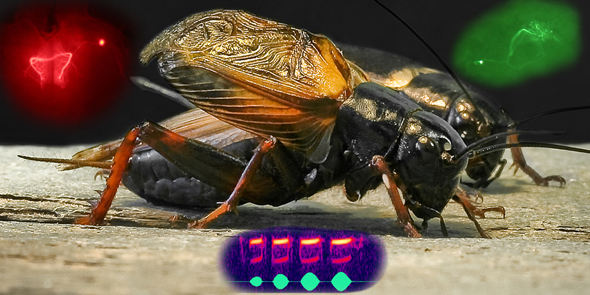
We focus on acoustically communicating insects to explore how the nervous system controls the generation of sound signals, and how nerve cells in the brain process these signals to allow species-specific recognition. In this way we use these insects as model systems to reveal fundamental principles of neuronal processing at the level of networks, nerve cells and molecules.
Current research topics include:
- Lifetime development of phonotactic behaviour
- The neuromuscular basis of acoustic steering in walking crickets
- Studying the neurons for pattern recognition in the brain
- The control of singing by command neurons
- The neuronal basis of species-specific singing behaviour
- Calcium imaging of auditory processing
Key Publications
Bent A, Hedwig B (2021) Tolerant pattern recognition: Evidence from phonotactic responses in the cricket Gryllus bimaculatus (de Geer). Proc Roy Soc B 288:20211889. https://doi.org/10.1098/rspb.2021.1889
Clemens J, Schöneich S, Kostarakos K, Hennig RM and Hedwig B (2021) A small, computationally flexible network produces the phenotypic diversity of song recognition in crickets. eLife 10:e61475. doi.org/10.7554/eLife.61475
Lin CC and Hedwig B (2021) Lesions of abdominal connectives reveal a conserved organization of the calling song central pattern generator (CPG) network in different cricket species. J Comp Physiol A. DOI 10.1007/s00359-021-01495-1
Jacob PF, Hedwig B (2020) Modular timer networks: abdominal interneurons controlling the chirp and pulse pattern in a cricket calling song. J Comp Physiol A. https://doi.org/10.1007/s00359-020-01448-0
Lv, M., Zhang, X., and Hedwig, B. (2020) Phonotactic steering and representation of directional information in the ascending auditory pathway of a cricket. J Neurophysiol. https://journals.physiology.org/doi/abs/10.1152/jn.00737.2019
Zhang, X and Hedwig B (2019) Bilateral auditory processing studied by selective cold deactivation of cricket hearing organs. JEB 222, jeb210799, doi: 10.1242/jeb.210799
